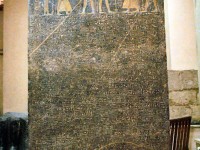
An example of Egyptian history-writing, the Merneptah stele. Public domain.
Historiography is the study of how history is written. For many people today, history has become journalistic, a simple retelling of “the facts about the past,” but history and history-writing is, in fact, far more complex than that. (See here for some Ensign articles on it.)
The history writer inevitably shapes the story told, sometimes in obvious and explicit ways, other times not. In the Bible, scholars must tentatively and carefully uncover the mind(s) behind the text. In the Book of Mormon, Mormon makes it much more transparent. Even when you have “facts,” the facts you choose to include and leave out, what you deem to be relevant, and the line you use to connect your chosen dots, means that you can sometimes tell very different stories with the same facts.
I illustrated this for my Seminary class with recut movie trailers, rendering The Shining an uplifting family-friendly piece, and Frozen and Mary Poppins horror films.
Combine that with the fact that in the ancient world, reading and writing were generally very difficult, costly, and limited-use skills to acquire. The details that are included in ancient scripture, then, very likely held significance to the author/editor, and are not merely the casual jottings like 8-yr old me, when told to write in my journal.
When we come into Alma 25, we read a story we’ve already read, but told from a different perspective. Alma and Amulek had been preaching in Ammonihah, where they were put in prison, and converts burned to death. In Alma 16:1, Mormon specifies that “there having been no wars nor contentions for a certain number of years.”
Why does Mormon include this detail? It means that when the Lamanites come out of the blue and destroy Ammonihah in 16:2-3, there is no earthly cause. I think that implicit there is that we are to understand that Ammonihah reaped what it had sown, and the Lamanites were the tool of God’s justice. That’s how Mormon shapes the story in chapter 16.
However, when we get to chapter 25, Mormon tells the story a different way. Recall that Ammon had preached and converted many people, who took on the name of Anti-Nephi-Lehis (or ANLs for short). Their conversion had sparked a civil war of sorts, leading to an attack on the ANLs. The ANLs, however, did not fight back. Mormon says that ” those Lamanites were more angry because they had slain their brethren; therefore they swore vengeance upon the Nephites; and they did no more attempt to slay the people of Anti-Nephi-Lehi at that time. But they took their armies and went over into the borders of the land of Zarahemla, and fell upon the people who were in the land of Ammonihah and destroyed them.” Mormon certainly knew this when we was writing chapter 16. But he shaped it to show that there was no human causality for the destruction of Ammonihah. Here in 25, though, we see exactly the chain of events that leads to Ammonihah’s destruction.
Now, there may be more behind the Lamanite reasoning to stop attacking the ANLs and attack Ammonihah instead. Warriors or prisoners captured in battle have a value and purpose that non-combatants (people who don’t fight back) do not have. (This from a Brant Gardner lecture here.)
The Book of Mormon in these chapters also has some things to say about conversion, deconversion, and reconversion. (I know these notes are abbreviated, but they’ll have to do for now.)
Conversion: Anti-nephi-lehis
Deconversion: Amulonites, Amalekites (who are really Amlicites)
What were the characteristics of each group that led to their situations of conversion or deconversion?
Anti-nephi-lehis
- came to reject Lamanite version of history, and accept the Nephite. (Again, what facts you choose, how you tell them, etc. can tell a very different story.) This is phrased as “traditions of fathers” (Alma 23:3, 24:7, 25:6,26:24)
- C.f. the importance of small plates as a political-religious document. (See post and links here.)
- Made and kept/lived covenants. Kept them even unto death. Alma 27:29
- Didn’t expect to be taken care of/humble/independent.
The Amulonites/Amalekites
- rejected Nephite traditions and history-writing
- pride/power hungry
After deconversion, there can still be reconversion: One Amulonite, Alma 23:14
As always, you can help me pay my tuition here, or you can support my work through making your regular Amazon purchases through this Amazon link. You can also get updates by email whenever a post goes up (subscription box on the right). If you friend me on Facebook, please drop me a note telling me you’re a reader. I tend not to accept friend requests from people I’m not acquainted with.
Recent Comments